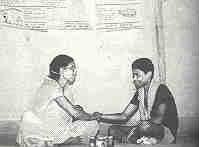Reviving rustic remedies
Reviving rustic remedies

MY FATHER-IN-LAW's khal-batta (mortar and pestle) should have gone to my husband, but today I am using it to revive the fading tradition of my forefathers," says a beaming Kamalbai Pendam, a trained female vaidu (ayurveda practitioner) in the faraway Maushi village of Gadchiroli district in Maharashtra. Using the family mortar and pestle, she makes various preparations and serves the village with dexterity and dedication. The villagers are all praise for her efforts.
Kamalbai is not alone in this revival; 21 other Arogya Sakhis, named so by Amhi Amachya Arogya Sathi (AAAS) - a Kurukheda-based NGO, working to revive the traditional, ayurvedic practice of medicine - are worthy heirs to this tradition.
For centuries, these humble vaidus have been treating people by making mixtures of different herbs without demanding money for their services as it was against their dharma (moral duty). But over time, a variety of reasons forced these traditions into oblivion and the vast reservoir of knowledge slowly faded away.
The AAAS took up the challenge and started interacting with the villagers and organising camps two years ago to train the vaidus. The concept of female vaidus emerged in one of these camps. "We realised that many men were not interested in continuing the profession of their fathers, but their wives showed enthusiasm to take up their fathers- in-law's tradition," says Gogulwar, the secretary of AAAS. And the idea of training women as Arogya Sakhis was born.
"Earlier, we could recognise only a few plants and did not have even a khal-batta. We would just pluck a few leaves and crush them on a rough stone. It had turned people away from us," says Sitaram Puram, a vaidu from Lendhari village. But then in the regularly held meetings and camps, these vaidus were trained to use modern equipments to make the concoctions; the women soon picked up.
However, not everyone can make the medicines themselves. To help them, the AAAS has developed a herbal nursery in Chichtola village, housing over 5,000 saplings to prepare various medicines. Vaidus can take these medicines on credit and after nominally charging the patients, they have to return 50 per cent of their earnings to the organisation.
Besides curing various ailments, these vaidus have also taken an active interest in prevention of disease. Proximity to their respective communities and the willingness to help their fellows has been a major reason for their success. Certainly, the project has revived the ayurvedic medical practices in the area and has extended a helping hand to the people. But it has failed to reduce the people's dependency on medical practitioners and witch doctors.







